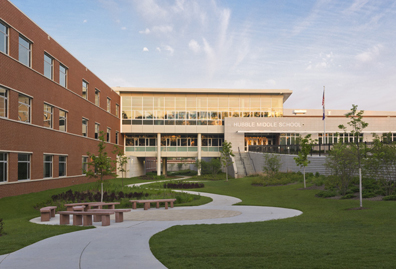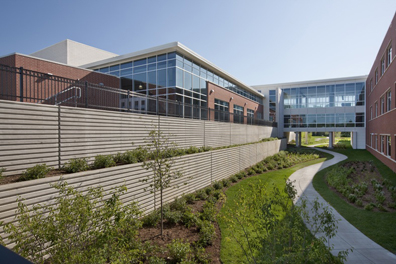Progress Report: Paul Pessetti, Legat Architects
Name: Paul Pessetti

Position: Senior Designer/Staff Architect
Years in the Education Design Field: 22 years
Education: Masters of Architecture, University of Illinois; Bachelor of Science in Architecture, University of Illinois
Hubble Middle School Awards: Award of Merit from the Illinois Association of School Boards; Middle School Citation from American School & University Magazine; and Project of the Year for Best in K-12 Education from Midwest Construction
Green construction may be a popular concept these days, but the concept of building sustainable, energy efficient school structures has been around a long time.
Paul Pessetti, senior designer and staff architect at Legat Architects, has been at the forefront of green building for most of his successful career. More recently, he and his company garnered accolades for the design of Hubble Middle School in Warrenville, Ill., which earned a LEED Gold certification from the U.S. Green Building Council.
“The firm itself has always done as much sustainable design as we can, even before the green certification came up, just in terms of making sure of the higher efficiency building envelopes and mechanical systems and the like,” says Pessetti. “So when Hubble came up and we had the opportunity with the green building, we really focused on that and dug in and kind of challenged the board a little bit.”
Pessetti began his career in the late 1980s, before the concept of green design became commonplace. He began working at Legat after graduating from college and quickly focused in on educational facilities, a primary project type for Chicago-based Legat.
“I kind of stumbled upon this company and it’s just kind of grown from there,” he explains. “They weren’t really teaching it in school. It wasn’t mainstream.”
Mainstream Green
It wasn’t until the formation of USGBC in 1993 that he noticed the push for sustainable design taking hold. “USGBC really kind of started forming and it was a couple of years before it really started taking off,” Pessetti says. “There were certain things some people were doing, but not widely.”
USGBC’s structure of prescribing points for particular design elements pushes designers to look at the entire building, rather than just one feature, he says. Components such as mechanical systems, insulation, windows, and materials all play a part. “It’s everything together. It’s a whole building solution. You can’t just focus on one aspect.”
Pessetti sees an improving future for green design, particularly in sustainable materials. For example, building materials with recycled content came with a premium price when green-building practices first came to the market. But now, manufacturers now find ways to incorporate recycled materials into their products and the costs are more comparable. “It’s just becoming more mainstream,” he says.
The next decade will bring new challenges as the economy takes it toll.
“Obviously, new buildings these days are fewer and farther between,” says Pessetti. He expects to see remodeling and retrofitting projects garner more attention, and LEED for Existing Buildings to play a bigger part.

LEED Gold for Hubble Middle School
The Hubble Middle School project is one of the first three Illinois facilities to obtain a gold LEED for Schools certification from the USGBC.
“They initially talked about doing a LEED Silver building and we actually ended up getting gold, which turned out really well,” says Pessetti.
The rating was a push, however, as the project needed 44 points to qualify for the gold rating and Pessetti thinks it received exactly that amount.
The new school opened in August 2009 and serves 1,080 students. It replaces a circa 1900’s facility that was in disrepair and also inconveniently located for the population it served. The concept probably materialized ten years ago, says Pessetti, when the Wheaton Warrenville Community Unit School District 200 began discussing ways to resolve issues at the school. The project moved more to the forefront around 2006 to 2007, about the same time Chicago’s Mayor Richard Daley cast legislation proposing all new school projects and public projects obtain a minimum LEED silver rating.
“I think the district kind of saw that as an opportunity as well to get involved with the green building,” says Pessetti.
A $58 million referendum financed the new school and expenses ended up close to that when all was said and done. Costs included the purchase of a more conveniently located, 22-acre site.
“It was a fairly challenging site, in terms of the location. It was kind of split into two parcels,” Pessetti explains. Playfields occupy one part of the site, and the other part has a steep drop off towards the back of the site. “But we took the opportunity and were able to do a three-story classroom mass and then a one-story main part that joined it at mid-level.”
Oil giant BP granted an in-perpetuity easement for an adjacent four- to five-acre parcel used for storm water detention. “By doing that, we were able to maximize the use of our site,” says Pessetti. “It’s a naturalized wetland, so it’s a planted, designed wetland for the storm water storage.”
Each floor of the 190,000 square foot school provides 10 general classrooms, six special education classrooms, two science labs and a faculty team room. Legat developed what it calls “the extended classroom”, with widened corridor areas in each pod enabling each grade level to be broken don into two groups. A Wi-Fi hotspot area outside each classroom cluster is used for breakout group sessions.
The one-story community building features a 340-seat cafeteria/commons room; a 500-seat auditorium; faculty offices; gymnasiums; a fitness center; a health classroom; and separate classrooms for band, music, orchestra and drama programs.
A green roof next to the library is used by students as a teaching tool, as well as a gathering spot. “Budget constraint-wise, we wanted to do more green roof, but we ended up only doing a smaller area for an education tool,” says Pessetti.
“The school is also doing something interesting with one of the innovative design credits: the school as a teaching tool,” Pessetti says. The credit requires a certain amount of contact hours of environmental design and talk about that in terms of the education. So science classes and different courses focus on different topics on green, such as measuring your carbon footprint or what have you. And they have actually taken it another step further; once a quarter they do a multi-grade level project where the kids pick a feature of the building or a topic related to environmental sustainability and they do a group project on it. The report is then presented to the school.”

Reaching the gold certification level required focus on details.
“We took a lot of the low-hanging fruit in terms of what things you could do,” says Pessetti.
Designers used permeable pavers in on of the two parking lot areas and landscaping that requires no irrigation. Also, bike racks and dedicated parking spaces for low-emitting and fuel-efficient vehicles are provided.
Construction utilized low-emitting materials with low or no VOCs, and regional materials comprised about 40 percent of the construction material. Recycled content was in the high 30 percent range. About 84 percent of construction waste was diverted from landfills. Water efficiency was addressed with automatic and low-flow fixtures, and dual-flush fixtures in all the urinals and water closets.
Budget constraints prohibited the used of solar power, but Legat looked for other ways to reduce energy use. “We actually have a dimming system – we call it light harvesting – in the classroom areas, where we have sensors on the lights that dim them as natural light comes in to maintain the prescribed level,” says Pessetti.
The entire building is designed to be about 24 percent more efficient that the baseline building and is thus far tracking close to that, he says.
